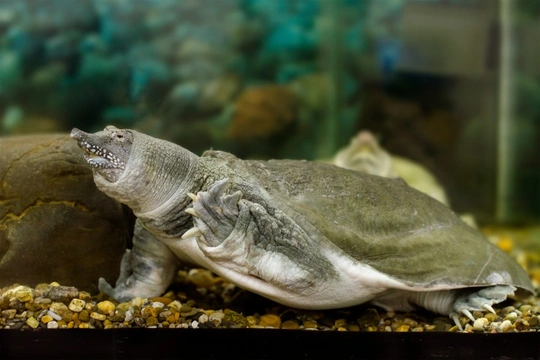
Keeping a soft-shelled turtle as a pet
The soft-shelled turtle is unique among turtle species, as their name implies, because they do not have the hard, brittle shell of most other species! There are three different sub-species within the type, all of which can make for suitable pets providing that you are prepared to take care of them properly and account for their potentially large size when fully grown.
If you are fascinated by turtles and are considering keeping turtles that are a little bit different to the norm, then soft-shelled turtles might be for you! Read on to learn more about soft-shelled turtles and how to care for them.
The three types of soft-shelled turtles
Soft-shelled turtles come in three distinct types:
- Spiny soft-shelled turtles, which have various spiny-looking protrusions on the exterior of the shell. These turtles are native to a wide range of areas including Canada, Mexico and California.
- Smooth soft-shelled turtles don’t have spines on their shells, and have shiny carapaces. They are often very impressively marked with large spots and patterns. These turtles are native to Florida, Texas and New Mexico, as well as being found in other areas of the USA too.
- Florida soft-shelled turtles are the largest variety, growing up to 20” across for females! They are, as the name suggests, native to Florida and the panhandle area.
Housing a soft-shelled turtle
Which type of soft-shelled turtle you wish to keep will largely dictate how large your tank should be; the Florida soft-shelled turtle grows rather large, and can weigh up to 40lb, while the other two varieties are rather smaller.
Both the spiny and the smooth soft-shelled turtles are a better pick for the domestic tank, as they take up less space and do not need an enormous enclosure! To keep them successfully, pick an aquarium of a minimum of 80 gallons volume, and preferably 100 gallons or more. Soft-shelled turtles are rather fragile, and require their water parameters to be kept in balance and very clean, and due to their soft outer shells, you must also take care that there is nothing in the water or the tank that might harm your turtle or cause them injury.
Because the water quality required for turtles must be so good, you should take care to ensure adequate filtration of the tank by means of a range of different filter mediums to clear both debris and bacteria and fungus from the tank, all of which can have an adverse effect on your turtles.
The substrate for the bottom of the tank should be soft sand, as this is what turtles seek out within their native environments in the wild. You will often find your turtles happily burying themselves within the sand substrate, and this is a natural and healthy behaviour that you should enable as much as possible.
Avoid using sharp sand or gravel, as these things may harm soft-shelled turtles, and provide a substrate deep enough to let your turtle dig about happily without hitting the base of the tank. Add some driftwood and smooth ornaments to the tank too, to provide a range of environments and allow your turtle to climb out of the water and bask when they wish to. Live aquarium plants also make a great addition to the soft-shelled turtle tank, but bear in mind that your turtles might like to eat them!
Lighting and heating
A water temperature within the mid 70’s range is ideal for soft-shelled turtles, which can be provided by using water heaters designed for fish tanks. Heat lamps in the roof of the tank can also be provided for warmth, and to provide a basking spot for your turtles to enjoy.
Like many reptiles, soft-shelled turtles will benefit greatly from the addition of UVB lighting within the tank, in order to help them to convert the calcium in their diet into nutrients. Without UVB lighting provision, your soft-shelled turtles are unlikely to thrive. UVB lights should be set on a timer, and used for 10-12 hours a day to provide optimum lighting in the tank.
Feeding soft-shelled turtles
In the wild, soft-shelled turtles eat a wide variety of different things, including insects, fish, amphibians and eggs, but they are very adaptable within the home and will eat a wide variety of things offered to them. Floating turtle pellets are fine to feed to soft-shelled turtles, and providing a balanced diet by means of adding crickets, meal worms and other insects that have been gut-loaded prior to feeding is also recommended.
Turtles prefer to eat in the water than on land, and so it is advisable to put your turtle’s food in the water and allow them to consume it there. Take care to feed your soft-shelled turtles a balanced diet, to clean out waste and uneaten food regularly, and to monitor your turtle’s food intake and weight to ensure that they remain healthy.



